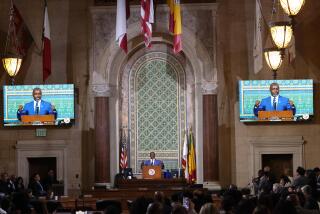Do you want poppycock with that?
- Share via
If the Los Angeles City Council were a reality television show, picking the right title would be a challenge. “America’s Silliest Local Legislators” has a nice sort of retro ring to it, but there’s a certain appealing simplicity to “Empty Gestures” too.
Either way, this week’s unanimous vote to prohibit the construction of fast-food restaurants in most of South Los Angeles for at least the next year would make an excellent pilot.
The ordinance’s ostensible purpose is to combat the county’s highest obesity and diabetes rates -- 30% of South L.A.’s adults are overweight, and 11.7% suffer from diabetes. It’s also true that the roughly 32 square miles south of the Santa Monica Freeway have a higher per capita concentration of fast-food outlets than the rest of the city, but far fewer restaurants or grocery stores of any type in absolute numbers. That’s all of a piece with the rest of life there, because about the only things the poor and working-class people of South L.A. have more of than the rest of the city are crime and all the things that contribute to and flow from ill health.
The notion that banning burger joints will do the slightest thing about any of that is worse than far-fetched, and the ordinance’s cloying nanny-state implications already have come in for well-deserved ridicule in the foreign and national media, as well as from redoubtable local voices of reason, like long-time community activist Joe Hicks.
It’s hard to know what to say when a news release from the measure’s sponsor, Councilwoman Jan Perry, alleges that holding McDonald’s at bay will “attract grocery stores and [sit-down] restaurants to the area by preserving existing land for these uses.” Presumably that was written with a straight face, because of course everyone knows that cutthroat competition with Jack in the Box for vacant building sites is what’s keeping Whole Foods and the Patina Group out of South L.A.
If all this was merely absurd, we all could have a derisive chuckle at the council’s expense and then move on. The problem is that the public health situation in South Los Angeles well may be this community’s worst moral and social disgrace -- and that’s saying something, because the list is long. It’s also a disgrace concerning which the council has done nothing but offer inconsequential, meaningless gestures masquerading as reform, like the fast-food moratorium.
Consider this: A recent national study by the New York Times found that South L.A. is “one of the most difficult places in the nation to receive ... medical care.” That’s because the number of people there who are uninsured or reliant on Medi-Cal has increased by 38% over the last eight years. Medi-Cal happens to offer physicians and hospitals the lowest per-capita reimbursement rate in the nation. That situation is about to get worse because Gov. Arnold Schwarzenegger’s budget -- assuming he ever gets it passed -- calls for a 10% cut in Medi-Cal funds. Along with proposed reductions in the federal Medicaid program, that means $240 million less for public health in South Los Angeles over the next year.
So has the council held hearings on the impact of these cuts, or passed resolutions of protest? Has it dispatched lobbyists to Sacramento, perhaps enlisting the help of the current and past Assembly speakers, both of whom are Angelenos?
No, not exactly -- though it now has made at least one part of the city safe from bacon cheeseburgers.
Then there’s the question of South Los Angeles’ public hospital. Oh, right. There hasn’t been one there since 2007, when the feds pulled Martin Luther King Jr.-Harbor Hospital’s accreditation and forced it to close after decades or negligence, malfeasance and outright corruption. Through all that, the council remained studiously silent, despite one damning newspaper story after another, culminating in the Los Angeles Times series that won a Pulitzer Prize for public service.
Although it’s true that the provision of public health services, including public hospitals, is a county responsibility, it is inexplicable that the council has not bombarded the Board of Supervisors with a stream of protests demanding a new public hospital for a region that falls mainly within the city limits. How is it possible that the poorest, sickest, neediest residents of this city can be left without adequate public health services in what one county health official calls “an all-out crisis,” and the 15 City Council members simply look the other way?
It was amusing this week to watch council members convene a multi-city, multi-public-agency conference on what to do about the horrifically pressing issue of aggressive paparazzi. In the two years since King-Harbor closed, no such meeting has occurred on what to do about the public health crisis in South Los Angeles, but what do the lives -- and deaths -- of tens of thousands of working people matter next to the right of celebrities to be photographed only when they wish to be photographed?
Maybe the council members are looking ahead to the time when their own reality show tops the ratings, though it’s a little hard to believe anybody ever would think these people are for real.
--
More to Read
Sign up for Essential California
The most important California stories and recommendations in your inbox every morning.
You may occasionally receive promotional content from the Los Angeles Times.













